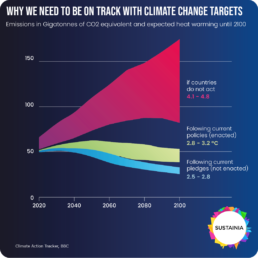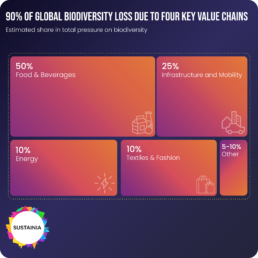Sustainia Simplifies
SBTi & Net Zero

SBTi & Net Zero – How adopting SBTi makes your climate tracking more efficient
As we race against time to avert climate change effects, a continuous assessment of stakeholder mandates toward the cause is warranted. Climate evaluations and targets at the corporate level are particularly vital given that companies are primarily responsible for greenhouse gas emissions which is a significant contributor to the climate crisis. To facilitate corporate social responsibility, the Science Based Targets initiative (SBTi), an alliance between the CDP, the United Nations Global Compact, World Resources Institute (WRI), and the World Wide Fund for Nature (WWF), exists to aid corporate entities in maneuvering the rigorous demands of private sector climate action. Among other functions, the partnership “promotes best practices in emissions reductions and net-zero targets in line with climate science, provides technical assistance and expert resources to companies who set science-based targets in line with the latest climate science, and provides companies with independent assessment and validation of targets.”
To appreciate the SBTi, a core examination of its mandate is necessary, especially when positioned alongside “net-zero targets.” While both terms are often used interchangeably, science-based and net-zero targets vary in applicability, specificity, and structure.
On net-zero, the United Nations Framework Convention on Climate Change’s (UNFCCC’s) “race to zero” campaign is instructive. Though the UNFCCC treaty is unequivocal about including non-state actors, companies, and financial institutions in the net-zero policy, the question of applicability remains elusive. Since corporate actors are generally not bound by international laws and treaties, any assumption that the policy enjoys automatic applicability among companies is gravely misconceived. Ideally, net-zero becomes directly applicable to and consequently enforceable against companies when state actors ratify and translate net-zero policy into national legislation. Considering the lengthy process of national law-making and the precariousness of the climate emergency, the SBTi is a viable solution. Though not obligatory, the initiative operates through a certification program that gives necessary credibility and importance to corporate climate strategy.
The specificity distinction stems from the vagueness surrounding net-zero processes. According to the UNFCCC, climate actors must strive for a climate-neutral world – ideally, below 1.5 to 2 degrees by 2050 – by meeting what it terms the “meta-criteria,” also referred to as the “five Ps,” i.e., pledge, plan, proceed, publish and persuade. Admittedly, this is a good start because stakeholders are introduced to the basic requirements of climate goal-setting. However, considering the complexities of companies’ business activities and supply chain management, the guide lacks sufficient depth to guide corporations toward their net-zero goals. Corporations affect and are affected by climate change in various ways with different outlooks, targets, and goals. As mentioned earlier, companies are notoriously known for massive climate violations. An aggregation of the preceding facts unequivocally reveals that adopting a generalist approach instead of a specific one is an exercise in futility. The SBTi not only reaffirms the need to halve emissions by 2030 and achieve climate neutrality by 2050 but also sets specific targets tailored to corporations’ needs, business activities, and sectors. The body also ensures that business targets follow clearly defined pathways and align with the latest climate science. Interestingly, the SBTi outlaws carbon offsets as a means toward emissions reductions, thereby mandating corporations to reduce emissions instead of facilitating carbon credits.
Though the UNFCCC’s net-zero interpretation guide provides detailed information on net-zero implementation and even covers company-specific information such as scopes 1, 2, and 3 emissions, the requisite structure needed to aid corporations in achieving their climate targets is lacking. The SBTi, on the other hand, operates through different groups, each with its function. For instance, in addition to the Executive Board, the SBTi has a “Technical Advisory Group (TAG)”, which is “a group of volunteer advisors from business, academia, government, non-profit and multilateral organizations who have in-depth knowledge about science-based target setting or expertise in voluntary emission reduction target setting in a corporate context.” A “Scientific Advisory Group (SAG)” also exists to “provide support developing benchmarks that enable companies to set medium- and long-term emissions reduction targets, and credible net-zero target models that incorporate carbon removal and nature-based solutions.” The “independent assessment and validation of targets” function is especially beneficial to companies that lack relevant scientific expertise personnel or require assistance in understanding how to meet their climate targets.
SBTi certification is a 5-step process that begins with a commitment and ends with disclosure. In addition to contributing to a more sustainable planet, SBTi certification helps companies set more ambitious and science-based targets for reducing their greenhouse gas emissions, draws more impact investors, consumers, and customers interested in sustainability and climate change, and gives companies a competitive edge in their respective industries by helping them set examples for other businesses. As of March 2023, over 2300 companies have set science-based targets with the SBTi. These companies, located worldwide, represent a wide range of sectors, including manufacturing, energy, transportation, and retail. The UNFCCC has duly recognized the importance of the SBTi by inviting businesses to engage with the initiative to set ambitious business climate targets. The SBTi is a powerful, moving train, and climate-conscious corporations will do well to get on board or risk getting left behind.



